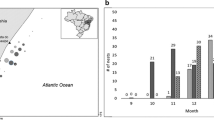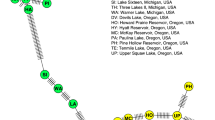Abstract
Following its introduction in the late nineteenth century, rainbow trout gradually spread to become one of the most widespread non-native fishes. Nevertheless, despite continuous introductions, they have become self-sustaining in only a limited number of European rivers, most of which are located in the Prealps. There is no consensus on the reasons for the absence of self-sustaining populations over most of Europe, though genetic differences have been suggested as a potential underlying factor. We conducted a population genetic study of the structure and origin of European populations to help resolve these questions. We examined variation in mitochondrial D-loop and the Y-linked marker of 41 self-sustaining, stocked, and hatchery populations from Europe and compared them to native and hatchery populations in North America. High levels of genetic diversity but little inter-population genetic variation suggests that European populations are derived from multiple sources, with a great majority of parental populations belonging to steelhead and coastal rainbow trout from Central and Northern California. Our study revealed no considerable genetic differences among European self-sustaining, stocked, and hatchery populations. The mitochondrial DNA data do not allow evaluation of selection and adaptive traits and thus cannot explain potential population differences arising in their naturalization success.




Similar content being viewed by others
References
Aurelle, D. & P. Berrebi, 1998. Microsatellite markers and management of brown trout Salmo trutta fario populations in southwestern France. Genetics Selection Evolution 30(Suppl 1): S1–S75.
Aurelle, D., G. Cattaneo-Berrebi & P. Berrebi, 2002. Natural and artificial secondary contact in brown trout (Salmo trutta, L.) in the French western Pyrenees assessed by allozymes and microsatellites. Heredity 89: 171–183.
Bagley, M. J. & G. A. E. Gall, 1998. Mitochondrial and nuclear DNA sequence variability among populations of rainbow trout (Oncorhynchus mykiss). Molecular Ecology 7: 945–961.
Bastian, M., S. Heymann & M. Jacomy, 2009. Gephi: an open source software for exploring and manipulating networks. In: International AAAI Conference on Weblogs and Social Media.
Beerli, P., 2006. Comparison of Bayesian and maximum-likelihood inference of population genetic parameters. Bioinformatics 22: 341–345.
Behnke, R. J., 1992. Native trout of western North America. American Fisheries Society, Bethesda.
Behnke, R. J., 2002. Trout and Salmon of North America. Free Press, New York.
Bousset, L., J.-P. Pointier, P. David & P. Jarne, 2013. Neither variation loss, nor change in selfing rate is associated with the worldwide invasion of Physa acuta from its native North America. Biological Invasions 16: 1769–1783.
Brudford, M. W., O. Hanotte, J. F. Y. Brookfield & T. Burke, 1998. Multilocus and single-locus DNA fingerprinting. In Hoelzel, A. R. (ed.), Molecular Genetic Analysis of Populations : A Practical Approach. IRL Press, Oxford: 287–336.
Brunelli, J. P., K. J. Wertzler, K. Sundin & G. H. Thorgaard, 2008. Y-specific sequences and polymorphisms in rainbow trout and Chinook salmon. Genome 51: 739–748.
Brunelli, J. P., C. A. Steele & G. H. Thorgaard, 2010. Deep divergence and apparent sex-biased dispersal revealed by a Y-linked marker in rainbow trout. Molecular Phylogenetics and Evolution 56: 983–990.
Busack, C. A. & G. A. E. Gall, 1980. Ancestry of artificially propagated California rainbow trout strains. California Fish & Game 66: 17–24.
Colwell, R. K. & J. A. Coddington, 1994. Estimating terrestrial biodiversity through extrapolation. Philosophical Transactions: Biological Sciences 345: 101–118.
Colwell, R. K., C. X. Mao & J. Chang, 2004. Interpolating, extrapolating, and comparing incidence-based species accumulation curves. Ecology 85: 2717–2727.
Crawford, S. S. & A. M. Muir, 2008. Global introductions of salmon and trout in the genus Oncorhynchus: 1870–2007. Reviews in Fish Biology and Fisheries 18: 313–344.
Ehrenbaum, E., 1926. Ueber regenbogenforellen und Steelheadforellen. Allgemeine Fischerei-Zeitung 51: 288–292.
Elton, C. S., 1958. The Ecology of Invasions by Animals and Plants. Wiley, New York.
Excoffier, L. & H. E. L. Lischer, 2010. Arlequin suite ver 3.5: a new series of programs to perform population genetics analyses under Linux and Windows. Molecular Ecology Resources 10: 564–567.
Fausch, K. D., 2007. Introduction, establishment and effects of non-native salmonids: considering the risk of rainbow trout invasion in the United Kingdom*. Journal of Fish Biology 71: 1–32.
Fausch, K., Y. Taniguchi, S. Nakano, G. Grossman & C. Townsend, 2001. Flood disturbance regimes influence rainbow trout invasion success among five holarctic regions. Ecological Applications 11: 1438–1455.
Gherardi, F., 2010. Invasive crayfish and freshwater fishes of the world. Revue scientifique et technique (International Office of Epizootics) 29: 241–254.
Glover, K. A., 2008. Genetic characterisation of farmed rainbow trout in Norway: intra- and inter-strain variation reveals potential for identification of escapees. BMC Genetics 9: 87.
Gross, R., P. Lulla & T. Paaver, 2007. Genetic variability and differentiation of rainbow trout (Oncorhynchus mykiss) strains in northern and Eastern Europe. Aquaculture 272(Supplement 1): S139–S146.
Hamilton, K. E., A. Ferguson, J. B. Taggart, T. Tomasson, A. Walker & E. Fahy, 1989. Post-glacial colonization of brown trout, Salmo trutta L.: Ldh-5 as a phylogeographic marker locus. Journal of Fish Biology 35: 651–664.
Hänfling, B., 2007. Understanding the establishment success of non-indigenous fishes: lessons from population genetics. Journal of Fish Biology 71: 115–135.
Heath, D. D., C. M. Bettles, S. Jamieson, I. Stasiak & M. F. Docker, 2008. Genetic differentiation among sympatric migratory and resident life history forms of rainbow trout in British Columbia. Transactions of the American Fisheries Society 137: 1268–1277.
Hecht, B. C., F. P. Thrower, M. C. Hale, M. R. Miller & K. M. Nichols, 2012. Genetic architecture of migration-related traits in rainbow and steelhead trout, Oncorhynchus mykiss. G3 2: 1113–1127.
Hecht, B. C., N. R. Campbell, D. E. Holecek & S. R. Narum, 2013. Genome-wide association reveals genetic basis for the propensity to migrate in wild populations of rainbow and steelhead trout. Molecular Ecology 22: 3061–3076.
Husseneder, C., D. M. Simms, J. R. Delatte, C. Wang, J. K. Grace & E. L. Vargo, 2012. Genetic diversity and colony breeding structure in native and introduced ranges of the Formosan subterranean termite, Coptotermes formosanus. Biological Invasions 14: 419–437.
Johnson, N. A., C. E. Rexroad, E. M. Hallerman, R. L. Vallejo & Y. Palti, 2007. Development and evaluation of a new microsatellite multiplex system for parental allocation and management of rainbow trout (Oncorhynchus mykiss) broodstocks. Aquaculture 266: 53–62.
Jug, T., P. Berrebi & A. Snoj, 2005. Distribution of non-native trout in Slovenia and their introgression with native trout populations as observed through microsatellite DNA analysis. Biological Conservation 123: 381–388.
Katoh, K. & D. M. Standley, 2013. MAFFT multiple sequence alignment software version 7: improvements in performance and usability. Molecular Biology and Evolution 30: 772–780.
Koskinen, M. T., T. O. Haugen & C. R. Primmer, 2002. Contemporary fisherian life-history evolution in small salmonid populations. Nature 419: 826–830.
Leitritz, E., 1970. Fish Bulletin 150. A History of California’s Fish Hatcheries 1870–1960. Californian Department of Fish and Game, Sacramento.
Larsson, A., 2014. AliView: a fast and lightweight alignment viewer and editor for large datasets. Bioinformatics 30: 3276–3278.
Librado, P. & J. Rozas, 2009. DnaSP v5: a software for comprehensive analysis of DNA polymorphism data. Bioinformatics 25: 1451–1452.
Lindholm, A. K., F. Breden, H. J. Alexander, W. Chan, S. G. Thakurta & R. Brooks, 2005. Invasion success and genetic diversity of introduced populations of guppies Poecilia reticulata in Australia. Molecular Ecology 14: 3671–3682.
Martsikalis, P., G. A. Gkafas, A. P. Apostolidis & E. Athanasios, 2014. Genetic structure profile of rainbow trout (Oncorhynchus mykiss) farmed strains in Greece. Turkish Journal of Fisheries and Aquatic Sciences 14: 749–757.
May, G. E., G. W. Gelembiuk, V. E. Panov, M. I. Orlova & C. E. Lee, 2006. Molecular ecology of zebra mussel invasions. Molecular Ecology 15: 1021–1031.
Mršić, V., 1935. Iskustva sa udomačenjem dužičaste pastrve u Jugoslaviji. Zagreb, Tisak Zaklade Narodnih Novina.
Needham, P. R. & R. J. Behnke, 1962. The origin of hatchery rainbow trout. Progressive Fish-Culturist 24: 156–158.
Nielsen, J., 1999. The evolutionary history of steelhead (Oncorhynchus mykiss) along the US Pacific Coast: developing a conservation strategy using genetic diversity. ICES Journal of Marine Sciences 56: 449–458.
Nolte, A. W., J. Freyhof, K. C. Stemshorn & D. Tautz, 2005. An invasive lineage of sculpins, Cottus sp. (Pisces, Teleostei) in the Rhine with new habitat adaptations has originated from hybridization between old phylogeographic groups. Proceedings of the Royal Society B 272: 2379–2387.
Rabitsch, W., N. Milasowszky, S. Nehring, C. Wiesner, C. Wolter & F. Eeel, 2013. The times are a changing: temporal shifts in patterns of fish invasions in Central European freshwaters. Journal of Fish Biology 82: 17–33.
R Core Team 2015. R A language and environment for statistical computing. R Foundation for Statistical Computing, Vienna. https://www.R-project.org/.
Roman, J. & J. A. Darling, 2007. Paradox lost: genetic diversity and the success of aquatic invasions. Trends in Ecology & Evolution 22: 454–464.
Rylková, K., L. Kalous, J. Bohlen, D. K. Lamatsch & M. Petrtýl, 2013. Phylogeny and biogeographic history of the cyprinid fish genus Carassius (Teleostei: Cyprinidae) with focus on natural and anthropogenic arrivals in Europe. Aquaculture 380–383: 13–20.
Signorile, A. L., J. Wang, P. W. W. Lurz, S. Bertolino, C. Carbone & D. C. Reuman, 2014. Do founder size, genetic diversity and structure influence rates of expansion of North American grey squirrels in Europe? Diversity and Distributions 20: 918–930.
Simberloff, D., 1989. Which insect succeed and which fail? In Drake, J. A., H. A. Mooney, F. di Castri, R. H. Groves, F. J. Kruger, M. Rejmánek & M. Williamson (eds), Biological invasions: a global perspective. Wiley, New York: 61–75.
Simmons, R. E., P. Lavretsky & B. May, 2010. Introgressive hybridization of redband trout in the upper McCloud River watershed. Transactions of American Fisheries Society 139: 201–213.
Simon, A., R. Britton, R. Gozlan, C. van Oosterhout, F. A. M. Volckaert & B. Hänfling, 2011. Invasive cyprinid fish in Europe originate from the single introduction of an admixed source population followed by a complex pattern of spread. PLoS One 6: e18560.
Snoj, A., T. Jug, E. Melkic, S. Susnik, J. Pohar, P. Dovc, D. Jesensek & N. Budhina, 2000. Mitochondrial and microsatellite DNA analysis of marble trout in Slovenia. Quaderni ETP 29: 5–11.
Stanković, D., A. Crivelli & A. Snoj, 2015. Rainbow trout in Europe: introduction, naturalization and impacts. Reviews in Fisheries Science & Aquaculture 23: 39–71.
Stephens, M. R., 2007. Systematics, Genetics and Conservation of Golden Trout. PhD Dissertation. University of California, Davis.
Stephens, M. R., N. W. Clipperton & B. May, 2009. Subspecies-informative SNP assays for evaluating introgression between native golden trout and introduced rainbow trout. Molecular Ecology Resources 9: 339–343.
Weiss, S., A. Antunes, C. Schlötterer & P. Alexandrino, 2000. Mitochondrial haplotype diversity among Portuguese brown trout Salmo trutta L. populations: relevance to the post-pleistocene recolonization of northern Europe. Molecular Ecology 9: 691–698.
Zardoya, R., A. Garrido-Pertierra & J. M. Bautista, 1995. The complete nucleotide sequence of the mitochondrial DNA genome of the rainbow trout, Oncorhynchus mykiss. Journal of Molecular Evolution 41: 942–951.
Acknowledgments
We are grateful to all the people who shared their data and knowledge on self-sustaining rainbow trout populations in Europe or provided samples, special thanks go to P. Berrebi, K. Bogataj, N. Bravničar, N. Cathcart, A. Crivelli, S. Fenoglio, G. Feuerstein, B. Glamuzina, M. Govedič, C. Hahn, D. Jesenšek, G. Pustovrh, N. Šprem, F. Unfer and M. Vaupotič. We thank I. Wilson for the English revision of the manuscript. The research was supported by Slovenian Research Agency.
Author information
Authors and Affiliations
Corresponding author
Additional information
Handling editor: Christian Sturmbauer
Electronic supplementary material
Below is the link to the electronic supplementary material.
Rights and permissions
About this article
Cite this article
Stanković, D., Stephens, M.R. & Snoj, A. Origin and introduction history of self-sustaining rainbow trout populations in Europe as inferred from mitochondrial DNA and a Y-linked marker. Hydrobiologia 770, 129–144 (2016). https://doi.org/10.1007/s10750-015-2577-6
Received:
Revised:
Accepted:
Published:
Issue Date:
DOI: https://doi.org/10.1007/s10750-015-2577-6




